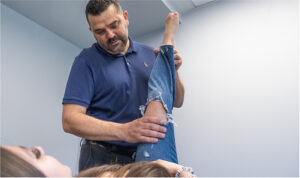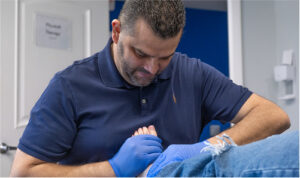Low Back Pain Physical Therapy
Overview
Low back pain is one of the most common musculoskeletal conditions, affecting mobility, daily activities, and work. It can result from poor posture, muscle strain, injuries, or underlying medical conditions. People experiencing back pain accompanied by numbness, weakness, or radiating pain down the legs.
Symptoms of Low Back Pain
- Dull or sharp pain localized in the lower back.
- Discomfort that worsens with prolonged sitting, standing, or bending.
- Muscle tightness or spasms.
- Reduced flexibility and range of motion.
- Pain that radiates to the hips, buttocks, or legs (sciatica).
Causes
The lower back supports the body’s weight, making it susceptible to strain and injury. Common causes of low back pain include:
Muscle strain: Overuse, heavy lifting, or sudden movements can strain muscles and ligaments.
Disc herniation: A bulging or ruptured disc can compress spinal nerves, leading to radiating pain.
Spinal stenosis: Narrowing of the spinal canal can put pressure on nerves, causing pain and weakness.
Poor posture: Sitting or standing incorrectly for extended periods can place undue stress on the lower back.
Trauma and injury: Falls, car accidents, or sports injuries can cause acute low back pain.
Underlying medical conditions: Conditions such as scoliosis, osteoporosis, and kidney infections can manifest as back pain.
Preventing Low Back Pain
Preventing low back pain involves proper posture and core strengthening. Consider these strategies:
- Practice good posture. Keep shoulders aligned with the hips and ears positioned over the shoulders.
- Adjust workspace ergonomics. Ensure the computer monitor is at eye level and avoid prolonged neck bending.
- Take breaks. If working at a desk or traveling for long hours, take frequent breaks to stretch and reposition.
- Sleep in a supportive position. Use a small pillow under the neck and avoid sleeping on the stomach.
- Stay active. Regular physical activity can help maintain spinal health and flexibility.
How Physical Therapy Can Help
Physical therapy plays a vital role in treating low back pain by improving mobility, reducing discomfort, and preventing future injuries. Common physical therapy interventions include:
- Manual therapy to alleviate muscle tension and enhance spinal mobility.
- Core stabilization exercises to strengthen the muscles supporting the lower back.
- Postural training to correct misalignment and prevent strain.
- Stretching and flexibility exercises to improve movement and reduce stiffness.
- Heat and cold therapy to manage inflammation and pain.
- Dry needling and massage therapy for deep muscle relaxation and pain relief.
Request an Appointment
If you are experiencing persistent or worsening neck pain, physical therapy may provide effective relief. Contact Us today to receive a personalized treatment plan tailored to your condition.


